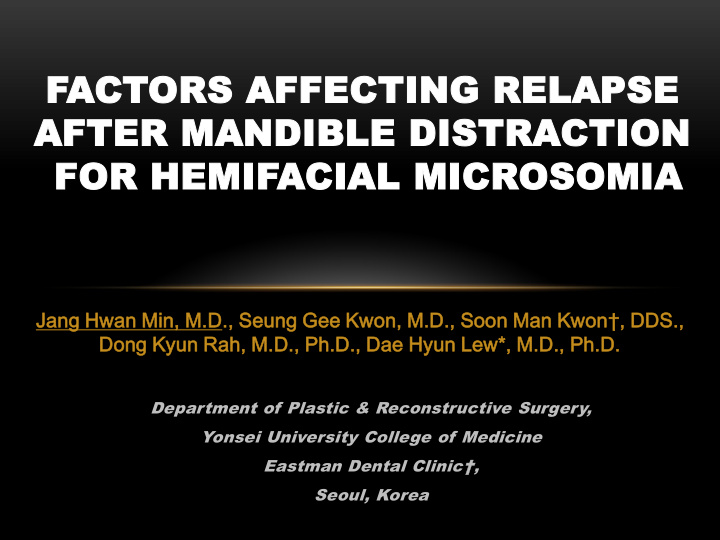



FACTORS AFFECTING RELAPSE AFTER MANDIBLE DISTRACTION FOR HEMIFACIAL MICROSOMIA Jang ng Hwan n Min, M.D., Seung ng Gee Kwon, M.D., Soon n Man Kwon † , DDS., Dong ng Kyun n Rah, M.D., Ph.D., Dae Hyun n Lew*, *, M.D., Ph.D. Department of Plastic & Reconstructive Surgery, Yonsei University College of Medicine Eastman Dental Clinic † , Seoul, Korea
HEMIFACIAL MICROSOMIA Incidence rate: 1/3500~1/5600 Facial asymmetry Unilateral underdevelopment • Mandible , maxilla, zygoma • External & middle ear • Associated soft tissue & muscle Disclosure: The authors have no conflict of interest to declare in relation to the contents of this article
RELAPSE OF DOG Controversy troversy PURPOSE Access factors influencing the relapse Define adequate amount of distraction
PATIENTS & METHODS Hemifacial microsomia (unilateral) 2000~2011, 25 25 cases. Mean follow up: 4yrs (range: 1yr~12yrs) Mean age : : 8.5yrs (range: 5yrs~37yrs) Male : F Female = 18 : : 7 7 Rt. : L Lt. (Affected side) = 1 14 : 1 11
OPERATIVE TECHNIQUE 2.Selection of pin site 3. Subtotal osteotomy 1.Design& Exposure 4.Pin insertion 5. Complete Osteotomy 6. Device application
PATIENTS & METHODS Group by distraction amount Group up 1 Group up 2 Group up 3 Group up 4 <10% 10%~2 ~20% 0% 20%~3 ~30% 0% >30% Group by initial severity affected / n non-affected side Group up A Group up B Group up C Group up D <10% 10%~2 ~20% 20%~3 ~30% >30%
PATIENTS & METHODS Serial AP c cephalometry Facial height measuring Serial Panoramic view Mandible ramus height measuring Measuring time T0(PreOp): Preoperative initial T1(EOD): End of distraction T2(LFU): Long term follow-up
FACIAL HEIGHT MANDIBLE HEIGHT
PATIENTS & METHODS Measurements Ratio: affected side / n non-affected side Amount of d distraction (%) Final amount of l lengthening (%) Relapse (%)
RESULTS : OVERALL HEIGHT
RESULTS : OVERALL RATE
RELAPSE RATE GROUP BY INITIAL SEVERITY Grou oup p A Grou oup p B Grou oup p C Grou oup p D <10% 0% 10%~2 %~20% 20%~3 %~30% >30% 0% * P<0.05
RELAPSE RATE GROUP BY DISTRACTION AMOUNT Grou oup p 1 Grou oup p 2 Grou oup p 3 Grou oup p 4 <10% 0% 10%~2 %~20% 20%~3 %~30% >30% 0% * P<0.0 0.05
CONCLUSION Factors affecting R Relapse Amount of distraction Group 4 ( (>30%): Relapse ↑ More distraction, more relapse Initial s severity Group D ( (>30%): Relapse ↑ More severity, more relapse
CONCLUSION For m minimize r relapse Adequate distraction amount Less than 30% distraction Not overcorrection Multistage distraction Enough post op orthodontics
Recommend
More recommend